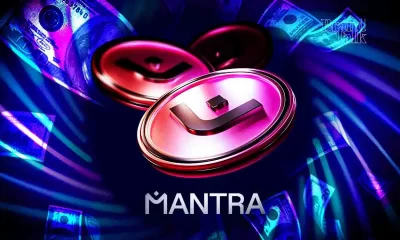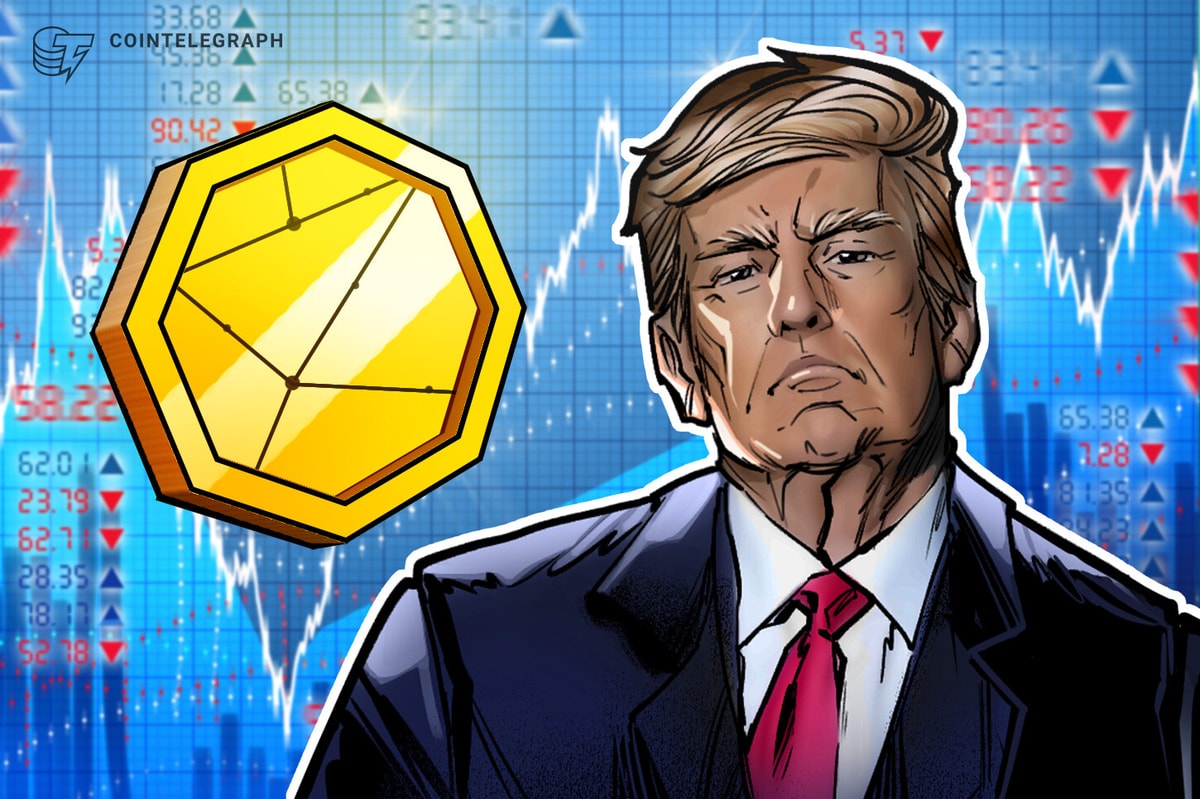Uncategorized
AI and blockchain — A match made in heaven
Published
1 week agoon
By
admin

Opinion by: Merav Ozair, PhD
Tech moguls cannot stop heralding the artificial intelligence revolution — from Bill Gates to Sundar Pichai to Jensen Huang — signaling that agentic AI and robotics will claim our jobs and act as our autonomous assistants performing on our behalf in our professional and personal lives.
Whether these scenarios happen in a few years or are decades away, we will most likely evolve into that future in some manner, and technology, once again, will reshape our lives. Without the support of blockchain technology, however, it would be quite difficult, and potentially impossible, for agentic AI and robotics to evolve to what its proponents expect them to.
If we expect these services and devices to act autonomously, security, privacy, transparency and accountability will be at the top of our minds. These areas are where blockchain shines and can support AI weaknesses to facilitate the scaling and evolution of this vision.
Blockchain strengths support AI weaknesses
Blockchain technology can significantly bolster the security of AI models by leveraging its key features such as decentralization, immutability, traceability, smart contracts, data privacy and identity verification. For example, but not limited to:
The decentralization aspect eliminates a single point of attack, increasing the resilience of AI models against breaches.
The immutability of blockchain ensures that the data used in training AI models and the models themselves cannot be illicitly altered, maintaining the integrity of the models.
Every alteration or decision made by the AI model can be audibly traced through blockchain, providing unparalleled transparency and accountability.
Smart contracts automate the enforcement of data access and usage rules, preventing unauthorized or unethical use of AI models.
Smart contracts can ensure that data is only used for training and testing and by authorized personnel, locking the option to be used for other purposes. Combining these rules with multiparty computation could prevent or at least mitigate AI adversarial attacks.
Blockchain allows secure multiparty computation, ensuring data privacy during AI model training by keeping the data decentralized.
Blockchain’s secure identity verification enhances the safety of AI systems by preventing unauthorized access.
Integrating AI with blockchain can establish a secure, transparent, traceable and decentralized AI environment, protecting our privacy, enhancing accountability and manifesting responsible AI.
Transactions: Programmable AI meets programmable blockchain
AI agents and robotics are programmable. Smart contacts, the driver of digital assets, are programmable. It makes perfect sense that digital assets would be the preferred payment rail for agent-to-human and agent-to-agent, which includes robotics.
Crypto is an internet-native, programmable money with several advantages for powering the agent-based economy. As AI agents become more autonomous and engage in micro-transactions at scale, crypto’s efficiency, borderless nature and programmability will make it the preferred medium of exchange over traditional fiat rails.
Recent: Sentient open-source AI search outperforms GPT-4o and Perplexity
The true intersection of Web3 and agentic AI for financial transactions could emerge through new tokens and protocols tailored for this use case. These could extend stablecoin capabilities by integrating agent-specific functionalities.
In this scenario, payments could be made using a specialized asset that agents can stake for quality control. Slashing policies could penalize poor performance, while validators could resolve disputes based on task quality.
Additionally, agents’ reputations could be directly tied to their token stakes. Incorporating rules via smart contracts enables users to have control over their autonomous workers/assistants, enabling a shutdown or even a “kill switch,” if necessary, when AI agents start behaving dangerously.
If Goldman Sachs wants to create AI agents that think and act like a seasoned employee in a highly regulated industry and with imperative risk to financial systems and at the extreme financial markets’ stability, it would be vital, not optional, to have these AI agents controlled by programmable tokens.
While this approach requires advancements in both Web3 and agentic AI, it is not as distant as it may seem.
Blockchain development firm Skyfire recently launched a payment platform that allows AI agents to spend money autonomously. Helmed by former Ripple vice president of products and services Amir Sarhangi, the company’s platform enables a business to give a pre-loaded wallet to an AI agent.
The company’s protocol converts the cash into USDC (USDC). In early March, Skyfire brought its payments network that enables AI agents to make autonomous transactions out of beta.
Using digital assets for robotics, VR devices and agentic AI transactions goes beyond a mode of payment for transactions. It could enhance user experience and security and enable endless business models that have never existed.
It would be interesting to see how it all plays out and whether other companies will follow.
There are risk issues to be addressed, however, and we should be mindful of how they are, at the very least, mitigated. This is where we should carefully consider the security measures discussed previously.
Stepping out of “tunnel vision” to a multifaceted approach
There is a lot of focus on the evolution of AI — generative AI, agentic AI, reasoning models, physical world models and more — all focusing on the premise that AI is the sole technology that we need to achieve AI autonomous agents at scale.
This is quite a tunnel vision approach to how products are built, and it is somewhat myopic: not understanding what needs to be accomplished beyond AI models’ advancement for the ecosystem to evolve and scale.
AI, advanced as it can be, cannot stand on its own and needs the support of blockchain technology — a programmable match made in heaven. Therefore, we must act in a multifaceted approach. We should think about and treat AI and Web3 together in terms of innovation, regulation and infrastructure. This is fundamental to the bedrock of a successful agentic economy.
“Dreams are built with solid foundations,” and the time to build them is now.
Opinion by: Merav Ozair, PhD.
This article is for general information purposes and is not intended to be and should not be taken as legal or investment advice. The views, thoughts, and opinions expressed here are the author’s alone and do not necessarily reflect or represent the views and opinions of Cointelegraph.
Crypto markets ‘relatively orderly’ despite Trump tariff chaos: NYDIG Fartcoin ‘Hot Air Rises’ — $1.50 Just A Whiff Away What happened to the RWA token? Crypto Strategist Sees Solana-Based Memecoin Surging Higher, Says One AI Altcoin Flashing Strong Chart Mantra Team Responds As The OM Token Price Crashes Over 80% In 24 Hours This Week in Crypto Games: Gaming Tokens Crash Out, Eve Frontier Opens Up Published on By Crypto markets have been fairly stable amid wider market panic caused by US President Donald Trump’s “on-again, off-again” sweeping global tariffs, according to a New York Digital Investment Group (NYDIG) analyst. “Despite the carnage in traditional financial markets, the crypto markets have been relatively orderly,” NYDIG global head of research Greg Cipolaro said in an April 11 note. “Historically, in broad risk-off moves, we tend to see stresses show up in crypto markets. We have yet to see that.” Cipolaro said crypto perpetual futures rates have “been persistently positive,” with liquidations spiking on April 6 and 7 in the days after Trump first announced the tariffs on April 2 but only to a total of $480 million, which he added “was well below other notable liquidation events.” He noted that the price of Tether (USDT), a US dollar-tracking stablecoin widely used token in crypto trading, was below $1 but had “not experienced a sharp decline.” Trump unveiled a sweeping tariff regime on April 2 that lumped various levies on every country before pausing them for 90 days just hours after they came into effect on April 9 and instead charging a base tariff of 10%, besides China, which currently has tariffs of up to 145%. Traditional and crypto markets tanked after Trump’s April 2 tariff announcement, and many assets haven’t recovered to the same level as before their unveiling. Stocks, bonds and foreign exchange volatility rates all rose after Trump’s tariffs announcement. Source: NYDIG Over the weekend, the Trump administration caused more confusion with its tariffs, saying on April 13 that an April 11 decision to exempt many electronics from tariffs was temporary and they would still be hit with levies. Cipolaro said that Bitcoin (BTC) didn’t escape the market volatility, “but at current prices has fared far better than many other asset classes.” He added that Bitcoin’s volatility hasn’t risen to historic levels, unlike the traditional markets, and “has been relatively stable” despite instability instigated by the Trump administration. “Perhaps investors are increasingly searching for stores of value not tied to sovereign countries and thus not affected by the trade turmoil.” Bitcoin is down 22.5% from its mid-January peak of over $108,000 and has traded flat over the past 24 hours at $84,730, according to CoinGecko. Cipolaro said the narrowing gap between Bitcoin’s volatility and other assets makes it “increasingly more appealing” to funds with risk parity portfolios — those that use risk to choose asset allocations. He added that investors are likely reducing their risk exposure but “perhaps some reallocation of asset mix to Bitcoin is one of the reasons it has been more buoyant.” Related: S&P 500 briefly sees ‘Bitcoin-level’ volatility amid Trump tariff war “Risk parity funds allocating to Bitcoin can help dampen its volatility — making the asset more attractive and potentially reinforcing a virtuous cycle of increased adoption and stability,” Cipolaro said. However, YouHodler chief of markets Ruslan Lienkha told Cointelegraph in an April 12 note that despite a wider market rebound, “technical indicators are painting a concerning picture.” He said a “death cross,” when the 50-day moving average crosses below the 200-day moving average, is potentially forming on Bitcoin and the S&P 500. Lienkha said the pattern is “generally considered a bearish signal for the medium term, suggesting that markets may struggle to sustain upward momentum without a clear catalyst or a stream of positive macroeconomic developments.” Magazine: Financial nihilism in crypto is over — It’s time to dream big again Published on By Commerce Secretary Howard Lutnick walked back the recent reciprocal tariff exemption on select electronics announced in an April 12 bulletin from the United States Customs and Border Protection. On April 13, Lutnick told ABC News that the reciprocal tariff exemption was temporary until the administration established a sector tariff regime for semiconductor products, which includes phones, graphics processors, and computing chips in a “month or two.” Lutnick added: “President Trump has called out pharmaceuticals, semiconductors, and autos. He called them sector tariffs, and those are not available for negotiation. They are just going to be part of making sure we ensure core national security items are made in this country.” “We can’t be relying on China for fundamental things we need. Our medicines and our semiconductors need to be built in America,” Lutnick continued. The official also said he was confident that the US and China would arrive at a trade deal through negotiations. The emphasis on national security and onshoring critical industries could signal that the trade tariffs will be a long-term geostrategic policy and not simply a short-term negotiation tactic to make US exports more attractive, as some analysts have suggested. The Volatility S&P Index (VIX), a measure of the S&P stock index’s volatility, remains elevated amid macroeconomic uncertainty. Source: TradingView Related: Bitcoin ‘decouples,’ stocks lose $3.5T amid Trump tariff war and Fed warning of ‘higher inflation’ Trump’s trade tariffs crashed the stock and crypto markets, wiping away trillions in shareholder value as investors dumped riskier assets on fears of a lengthy trade war between the United States and its trading partners. In an April 10 X Post, Bloomberg analyst Eric Balchunas cited the SPY US Equity History Volume chart as evidence that the S&P 500 stock market index is now more volatile than Bitcoin (BTC). According to the analyst, the S&P 500 Index hit a volatility level of 74 in April, compared to Bitcoin’s 71. Stocks and crypto pumped following rumors of the Trump administration initiating a 90-day reciprocal tariff pause. Approximately $2 trillion was pumped into stocks on rumors of softer trade policies. Much of this value was then wiped away when Trump claimed that rumors of a 90-day pause were false and returned once the Trump administration did, in fact, issue a reciprocal tariff pause in the following days. Magazine: Financial nihilism in crypto is over — It’s time to dream big again Published on By Bitcoin (BTC) hit an eleven-day high on April 13 as the crypto market relief rally closely tracked US financial policy changes. BTC/USD 1-hour chart. Source: Cointelegraph/TradingView Data from Cointelegraph Markets Pro and TradingView showed BTC/USD reaching $86,000 for the first time since April 2. The pair had reacted well to news that US President Donald Trump had decided to exclude certain key products from his ongoing trade tariffs against China. Traditional markets are closed on weekends —creating lower-liquidity trading in crypto markets and raising the chance for price volatility— with Bitcoin subsequently dropping under $84,000. With hours to go until the weekly close, BTC/USD was thus up 7% for the week, having started with a trip to new five-month lows. Commenting, traders were cautious over BTC price strength. Call me crazy but I don’t think I trust this breakout on $BTC. Low volume, overbought stoch, and on a weekend. If we can remain over 84k through Monday I’ll look for higher but for now this seems sketchy. pic.twitter.com/qKVdYAOYPJ — Roman (@Roman_Trading) April 12, 2025 Daan Crypto Trades noted the ongoing interplay with the 200-day exponential moving average (EMA) at $85,000. “This is however still a weekend move so far and we know next week will be volatile again with news regarding tariffs and the first big tech earnings coming up,” part of a post on X read. BTC/USD 1-day chart with 200 EMA. Source: Cointelegraph/TradingView Well-known trader Peter described the rebound from the lows as looking “more corrective than it does impulsive.” BTC/USD 2-hour chart. Source: Peter Brandt/X Popular trader and analyst Rekt Capital meanwhile saw the true hurdle to a Bitcoin bull market rebound coming in the form of a stubborn long-term daily downtrend. “Bitcoin has Daily Closed above the Downtrend. Thus, breakout confirmation is underway,” one of his latest X updates explained alongside an illustrative chart. “However BTC has previously Daily Closed above the Downtrend but failed its retest (a few of the red circles). Retest needs to be successful and it is in progress.” BTC/USD 1-day chart. Source: Rekt Capital/X As Cointelegraph reported, the daily downtrend, in place since late 2024, is earmarked as a key hurdle for bulls to overcome. Related: Bollinger Bands creator says Bitcoin forming ‘classic’ floor near $80K Another post flagged promising signals on Bitcoin’s relative strength index (RSI) indicator. A classic leading indicator, RSI continued to print another bullish divergence with price on daily timeframes. “Bitcoin is developing yet another Higher Low on the RSI while forming Lower Lows on the price,” Rekt Capital summarized. “Overall, throughout the cycle Bitcoin has formed Bullish Divergences like this on a few occasions already. Each Bull Div preceded reversals to the upside.” BTC/USD 1-day chart with RSI data. Source: Rekt Capital/X This article does not contain investment advice or recommendations. Every investment and trading move involves risk, and readers should conduct their own research when making a decision. Arthur Hayes, Murad’s Prediction For Meme Coins, AI & DeFi Coins For 2025 Expert Sees Bitcoin Dipping To $50K While Bullish Signs Persist Aptos Leverages Chainlink To Enhance Scalability and Data Access Bitcoin Could Rally to $80,000 on the Eve of US Elections Crypto’s Big Trump Gamble Is Risky Institutional Investors Go All In on Crypto as 57% Plan to Boost Allocations as Bull Run Heats Up, Sygnum Survey Reveals Sonic Now ‘Golden Standard’ of Layer-2s After Scaling Transactions to 16,000+ per Second, Says Andre Cronje Ripple-SEC Case Ends, But These 3 Rivals Could Jump 500x
Source link You may like












Uncategorized
Crypto markets ‘relatively orderly’ despite Trump tariff chaos: NYDIG

Bitcoin fares well, declining volatility to make it widely attractive
Source link Uncategorized
Commerce Secretary Lutnick walks back tariff relief on electronics

Trade war heightens volatility and sends markets tumbling
Source link Uncategorized
Bitcoin price tags $86K as Trump tariff relief boosts breakout odds

Bitcoin traders say brace for more volatility
RSI bullish divergence still in play
Source link Michael Saylor Teases New Bitcoin Buy After Strategy’s $7.69 Billion Q1 BTC Buying Spree

Crypto markets ‘relatively orderly’ despite Trump tariff chaos: NYDIG

Fartcoin ‘Hot Air Rises’ — $1.50 Just A Whiff Away

What happened to the RWA token?

Crypto Strategist Sees Solana-Based Memecoin Surging Higher, Says One AI Altcoin Flashing Strong Chart

Mantra Team Responds As The OM Token Price Crashes Over 80% In 24 Hours

This Week in Crypto Games: Gaming Tokens Crash Out, Eve Frontier Opens Up

Commerce Secretary Lutnick walks back tariff relief on electronics

Gold ETF Inflows Hit Three-Year High as PAXG, XAUT Outperform Wider Crypto Market

Israel’s New Study Shows 51% Of Public Is Interested In Adopting CBDC (Digital Shekel) – Is That So?

Solana Price Eyes Breakout Toward $143 As Inverse Head & Shoulders Pattern Takes Shape On 4-hour Chart

Crypto malware silently steals ETH, XRP, SOL from wallets

Binance Executives Met With US Government Officials To Discuss Easing of Regulatory Supervision: Report

Michael Saylor Hints At Another MicroStrategy Bitcoin Purchase, BTC Price To Rally?

From the Crypto Trenches to the Hill: Why Solana Is Making a Big Push in Washington

Arthur Hayes, Murad’s Prediction For Meme Coins, AI & DeFi Coins For 2025

Expert Sees Bitcoin Dipping To $50K While Bullish Signs Persist

Aptos Leverages Chainlink To Enhance Scalability and Data Access

Bitcoin Could Rally to $80,000 on the Eve of US Elections

Crypto’s Big Trump Gamble Is Risky

Institutional Investors Go All In on Crypto as 57% Plan to Boost Allocations as Bull Run Heats Up, Sygnum Survey Reveals

Sonic Now ‘Golden Standard’ of Layer-2s After Scaling Transactions to 16,000+ per Second, Says Andre Cronje

Ripple-SEC Case Ends, But These 3 Rivals Could Jump 500x

Has The Bitcoin Price Already Peaked?

A16z-backed Espresso announces mainnet launch of core product

The Future of Bitcoin: Scaling, Institutional Adoption, and Strategic Reserves with Rich Rines

3 Voting Polls Show Why Ripple’s XRP Price Could Hit $10 Soon

Xmas Altcoin Rally Insights by BNM Agent I

Blockchain groups challenge new broker reporting rule

I’m Grateful for Trump’s Embrace of Bitcoin
Trending


















